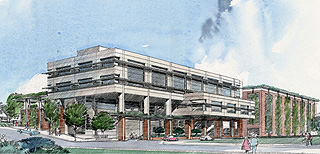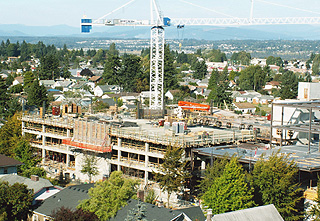
Surveys
DJC.COM
October 26, 2006
Designing a cancer center for 4 competitors
Special to the Journal

Image courtesy of Anshen + Allen The first major project in a $400 million expansion and modernization by Providence Everett Medical Center is this $62.4 million cancer center. It will be finished next May. |
A $62.4 million, 100,000-square-foot cancer diagnostic and treatment center being built in a north Everett neighborhood has posed some unusual challenges for architects and contractors.
Designed by Anshen + Allen of Seattle and built by Mortenson’s Bellevue office, the five-story Providence Everett Medical Center project is the first phase of a $400 million, 10-year expansion and modernization of PEMC’s aging Colby Avenue complex.
The key to establishing the cancer-care facility is the unusual collaboration by Everett health-care providers who are generally competitors, said Jean McMahon, executive director of the cancer center.
“The whole idea of the center is to provide seamless cancer care for patients and use economies of scale for the providers by partnering in a single facility instead of using scattered facilities that are less efficient for everyone, particularly the patient,” McMahon said.
The cancer care partners include Providence Everett Medical Center, The Everett Clinic, Western Washington Medical Group and Northwest Washington Radiation Oncology Associates.
While PEMC is overseeing the $62.4 million project, $12 million in radiation oncology technology is being financed by the other three partners. All four have collaborated in planning the design and arrangement of facilities in the new center.

Photo courtesy of Providence Everett Medical Center One of the major construction challenges for the project is its residential setting. |
When the project is completed next summer, much of the cancer care for patients in Snohomish, Skagit, Whatcom, Island and San Juan counties will be concentrated in one facility.
In its first year of operation, the new cancer center is expected to serve more than 2,500 new patients, plus those needing follow-up care. It will provide all cancer diagnostic and treatment services available at Seattle’s Cancer Care Alliance except for bone-marrow transplants.
Design challenges
The many challenges of constructing the unusual cancer center for its four partners began in the design stage.
“We had to design the building for integrated patient cancer care, which includes four concrete-lined linear accelerators for radiation treatment, electronic imaging equipment and a central electronic information system for tracking all patient records and making them commonly accessible to medical staff,” said Adam Kerner, an Anshen + Allen principal and the lead architect on the project.
He said all 24 chemotherapy treatment units had to be located on the east side of the third floor, with large windows offering views of the Cascade Mountains for patients during their treatments. Medical departments had to be designed to reflect their own identities yet blended to function in a collaborative, unified environment with four separate medical organizations.
“From our perspective, our challenge was to design the building as a warm, welcoming immersion experience for cancer patients but also accommodate medical needs, including technology such as large, noisy radiation equipment,” Kerner said.
Energy-efficient building
Other design approaches were needed for the top two floors, which will be filled with medical offices that won’t necessarily be connected to the cancer center’s first three floors, he said. A roof garden will provide rest areas for families and friends visiting patients.
“Although it’s not designed to green-built LEED standards specifically, there are energy-efficient elements, such as extensive shading on the east side, since it gets a lot of direct sunlight in the morning. Also, the building’s heating, cooling and mechanical devices are computer-controlled and very energy-efficient,” Kerner said.
He had to plan for building materials that didn’t give off chlorine or other gases that could affect sensitive patients or the facility’s air quality. The center also will use ozone-friendly refrigerants.
“Traditionally, health-care facilities have used PVC-producing materials because they are so durable. There’s been a real effort in recent years to reduce the use of those materials to reduce PVCs in such environments. We also are using paints with very low odors to contribute to better air quality,” he said.
The architectural challenges, Kerner said, were made easier by the dedication of the four partners to providing an integrated cancer care facility. Since they all shared a common vision, he said, the decision-making process for the design of the building, the selection of materials, floor plan arrangements and other elements was “much more straight forward than might have been expected.”
Quiet zone
Michael Harder, Mortenson’s executive in charge of the project, said reducing noise has been a priority for the site work because the project is bordered by a residential neighborhood on three sides and a hospital with quiet zones on the fourth side.
“One thing we’ve done to limit the noise and disruption to the neighborhood is working with only one access point into the site. We’ll actually finish the adjacent 489-car parking garage before the cancer center but they’ll both open at the same time because of the single road. There’s no way to get to the garage until the center is finished, too,” Harder said. “It’s good for the neighbors but it’s challenging for us.”
Another challenge was installing tons of concrete for the floors, walls and ceiling of four linear accelerator vaults used for radiation treatment, he said. Also, builders have been faced with a variety of office styles and arrangements to suit the needs of the four partners, plus special medical needs, “but it’s a lot more exciting to work on than just an office building,” Harder said.
On the other hand, what has made the project easier, he said, is having a good construction team.
“University Mechanical in Mukilteo is handling the HVAC and plumbing, Veca Electric & Communication Systems in Seattle is on the site and The Erection Co. in Arlington did the steel work. We’re also working with CDi Engineers and Sparling in Lynnwood,” he said.
Terry Stephens is a freelance writer based in Arlington. He can be reached by e-mail at features@gte.net.
Other Stories:
- Victoria project goes from brown to green
- Should design firms grow and change?
- Retail plays a bigger role in mixed-use
- In with the old, in with the new
- Designers bet urban dwellers want more
- Dream team designs downtown penthouses
- Healthy buildings’ role in organic modernism
- Queen Anne readies for icons old and new
- Keeping the bad guys out of banks
- Surviving today’s tough bid climate
- Why marketing during the good times is critical
- Getting creative with your feasibility analyses
- Hotels and condos: mixed-use matrimony
- School’s design reflects its humanist curriculum
- Seattle’s waterfront: 100 years of hidden history
Copyright ©2009 Seattle Daily Journal and DJC.COM.
Comments? Questions? Contact us.